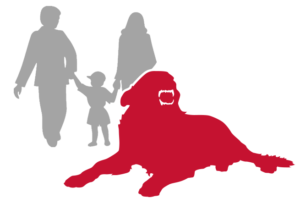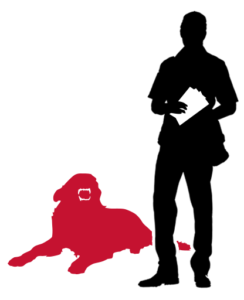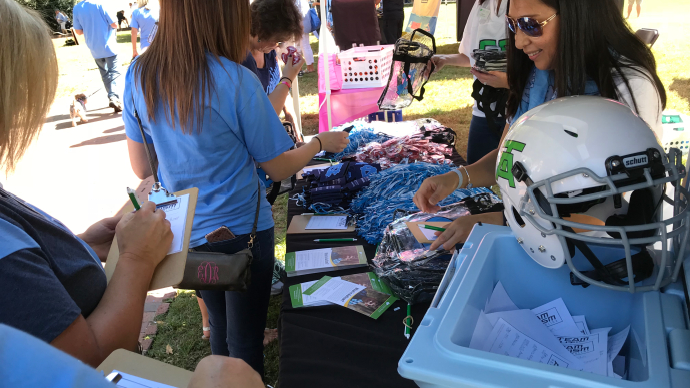
Dog bites are a serious concern. About 4.5 million Americans are bitten by dogs each year and half of the victims are children, according to the Centers for Disease Control and Prevention. Almost one in five of the victims who are bitten require medical attention for dog bite related injuries.
Adults should recognize and children should be taught that any dog can bite. Children should learn to approach dogs with caution, especially dogs that are unfamiliar.
Prior to attacking and biting, an agitated dog is likely to exhibit increasingly intense behaviors, which the WebMD site says may occur in sequence or simultaneously. They include:
- Becoming very still and rigid,
- Guttural bark that sounds threatening,
- Lunging forward or charging at the person with no contact,
- Mouthing, as though to move or control the person, without applying significant pressure,
- “Muzzle punch” (the dog literally punches the person with her nose),
- Snarl (a combination of growling and showing teeth),
- Showing teeth,
- Snap at air,
- Growl.
Among the reasons a dog may become aggressive and bite according to dog whisperer.
Top 5 Reasons Why A Dog Might Bite
 Possessiveness
Possessiveness
A dog will by instinct protect its territory. This is why there are guard dogs. But in addition to protecting a home or master, a dog will also be possessive of toys, food (including bones), and their beds. Never bother a dog that is eating and do not try to take a toy, bone, or other possession away from a dog that you do not know well.
 Fear
Fear
Many dogs that bite are striking out of fear for their own safety. Dogs may become fearful in unfamiliar situations, such as if approached by a stranger. This explains why postal and utility workers and other delivery personnel are at risk of being bitten by dogs. In most cases, a fearful dog would just as soon run away as bite (the “flight or fight” response). As you approach any dog, make sure it is not cornered so that it can retreat from you if afraid. Do not approach a dog from behind or startle it. On the other hand, do not turn your back on a fearful dog; it could attack from behind.
 Pain
Pain
A dog may lash out because it is in pain. This may partly be fear of additional pain and partly frustration from not being able to reduce or eliminate the pain they are experiencing, like any cranky patient. Be cautious of a dog that is licking a wound or that is obviously injured. Chronic illness, such as hip dysplasia or periodontal disease, can be painful, so be cautious of elderly dogs. Dogs subjected to training equipment, like the pinch (or prong) collar or the shock collar, may also react to the pain by biting.
Protective Aggression
If not domesticated, dogs live in packs and by nature are protective of members of their pack. Among domestic dogs, the “pack” may include the dog’s owner and other family members, particularly vulnerable human family members and even other pets in the home. Small children should never be left alone with a dog, no matter how stable the dog’s disposition. In addition, female dogs are very protective of their puppies. If a dog thinks its puppies or members of its pack are being threatened, it may act aggressively to protect them. Be careful around dogs that have recently given birth and when playing roughly with members of a dog’s “pack,” especially if the dog does not know you well.
Predatory Aggression
Dogs also possess the instinct of predators, which means they have a drive to stalk, chase, and “take down” prey. The predatory instinct is more pronounced in some breeds that in others, and may be sparked by a passing car, bicyclist, jogger, or running child, as well as by other animals, such as a squirrel. If a dog runs at you, it is best to stand still and as upright as possible to look large. Allow the dog to approach and identify you by sniffing you. Do not make eye contact with the dog; direct eye contact may be seen as a challenge.
Owning a dog comes with responsibility. A dog owner has a responsibility to make reasonable attempts to ensure that their dog does not bite anyone. This may include keeping it indoors, penned, or on a leash. If you or a family member have been bitten by a dog, you may be able to hold the owner liable and obtain compensation for the cost of your injury, including medical expenses and lost wages. Your decision to hold a dog owner accountable for their dog’s biting may prevent another person from suffering similar injuries.
A dog bite injury lawyer from Hardison & Cochran can discuss a potential dog bite claim with you if you have suffered such an injury in North Carolina.




1 Comment
3beautiful dog put down because they bite…no one tryed to find out WHAY…..